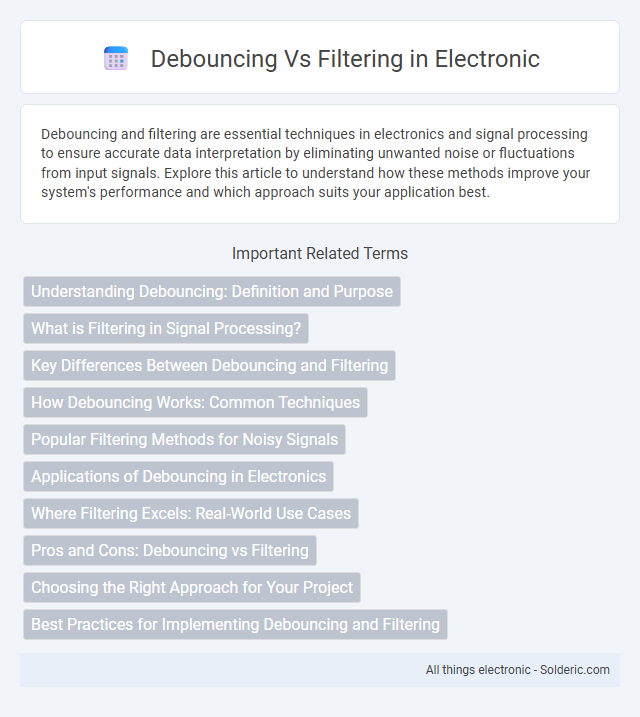Debouncing and filtering are essential techniques in electronics and signal processing to ensure accurate data interpretation by eliminating unwanted noise or fluctuations from input signals. Explore this article to understand how these methods improve your system's performance and which approach suits your application best.
Comparison Table
| Aspect | Debouncing | Filtering |
|---|---|---|
| Purpose | Eliminates rapid, repetitive signals from a single input event | Removes unwanted noise or smooths signal fluctuations |
| Application | Input devices like buttons, switches | Sensor data, signal processing, audio |
| Method | Ignores additional inputs for a set time after first event | Applies algorithms (low-pass, moving average) to the signal |
| Result | Single valid signal per input action | Smoothed, stabilized output signal |
| Implementation | Software timer or hardware delay circuits | Digital filters, analog circuits, software algorithms |
| Use Case | Prevent button bounce errors in digital inputs | Reduce sensor measurement noise, improve data quality |
Understanding Debouncing: Definition and Purpose
Debouncing is a technique used in electronics and software to ensure a single signal or input is registered accurately by eliminating noise or repeated signals caused by mechanical or electrical inconsistencies. Its primary purpose is to stabilize input readings from devices such as buttons, switches, or sensors by preventing false triggers or multiple counts in rapid succession. Effective debouncing enhances system reliability and response accuracy in embedded systems and user interfaces.
What is Filtering in Signal Processing?
Filtering in signal processing involves removing unwanted components or noise from a signal to enhance its quality and clarity. It applies mathematical algorithms or hardware circuits, such as low-pass, high-pass, or band-pass filters, to selectively allow desired frequencies while attenuating others. Understanding filtering helps you improve signal reliability and accuracy in various applications like audio processing, communications, and sensor data analysis.
Key Differences Between Debouncing and Filtering
Debouncing eliminates signal noise by ignoring rapid, successive changes within a short time frame, typically used in mechanical switch inputs to prevent multiple triggers. Filtering smooths signal fluctuations by averaging or attenuating frequencies, essential for reducing high-frequency noise in sensor data or analog signals. The key difference lies in debouncing managing temporal input stability, while filtering focuses on frequency-based signal refinement.
How Debouncing Works: Common Techniques
Debouncing works by ensuring that only a single signal or event is registered within a specified time frame, effectively ignoring any noise or fluctuations caused by mechanical switches or rapid user inputs. Common techniques include hardware debouncing using RC circuits which filter out rapid changes through capacitance and resistance, and software debouncing that uses timers or delays to confirm input stability before registering the input. Both methods aim to provide clean, stable signals to microcontrollers by suppressing false triggers caused by switch bounce or electrical noise.
Popular Filtering Methods for Noisy Signals
Popular filtering methods for noisy signals include low-pass filters, which effectively remove high-frequency noise while preserving the essential signal components. Median filters are widely used for their ability to eliminate impulsive noise by replacing each data point with the median of neighboring values. Kalman filters provide optimal estimation by combining noisy measurements and model predictions, making them suitable for dynamic systems with uncertain noise characteristics.
Applications of Debouncing in Electronics
Debouncing is essential in electronics to eliminate false signals caused by mechanical switch vibrations, ensuring accurate and stable input readings in devices like keyboards, microcontrollers, and control panels. It is often implemented in digital circuits and embedded systems to prevent multiple triggers from a single button press, improving reliability in user interfaces and industrial controls. Your electronic projects benefit from debouncing by reducing noise, enhancing signal integrity, and providing consistent performance in real-time applications.
Where Filtering Excels: Real-World Use Cases
Filtering excels in real-world applications where continuous sensor data needs smoothing to reduce noise and prevent false triggers, such as in temperature monitoring systems and audio signal processing. Its ability to handle fluctuating inputs allows your devices to maintain accurate readings without missing subtle variations. Unlike debouncing, which targets discrete signal stabilization, filtering effectively enhances overall signal quality in dynamic, noisy environments.
Pros and Cons: Debouncing vs Filtering
Debouncing effectively eliminates noise from mechanical switches by ensuring a signal stabilizes before registering, reducing false triggers but introducing slight input delay. Filtering processes sensor data using algorithms like low-pass filters to smooth out fluctuations, offering continuous output without delayed response but sometimes failing to fully remove rapid transients. Debouncing is best suited for digital input stabilization, while filtering excels in analog signal conditioning, each with trade-offs in latency and noise suppression accuracy.
Choosing the Right Approach for Your Project
Debouncing is ideal for scenarios where you need to ensure a single response to rapid input changes, such as button presses in user interfaces, by delaying the action until the input stabilizes. Filtering, including techniques like low-pass or median filtering, excels in smoothing noisy sensor data by continuously refining measurements to reduce fluctuations. Your choice depends on whether your project prioritizes eliminating transient signals or smoothing continuous data streams for reliable output.
Best Practices for Implementing Debouncing and Filtering
Implementing debouncing effectively requires setting an optimal delay time to ensure your system ignores rapid, successive signals without missing legitimate inputs, typically between 20ms to 50ms for mechanical switches. Filtering best practices involve using low-pass filters or moving average algorithms to smooth out noisy data, enhancing signal stability in sensor readings. Your choice between debouncing and filtering depends on the noise type and application, with debouncing ideal for mechanical noise and filtering suited for continuous analog signal refinement.
Debouncing vs Filtering Infographic

 solderic.com
solderic.com